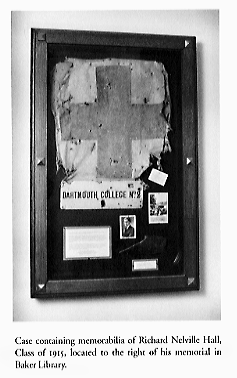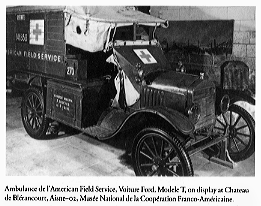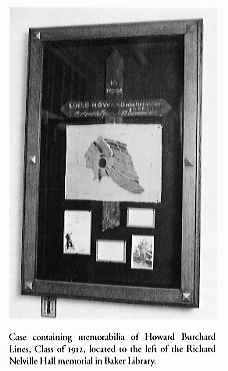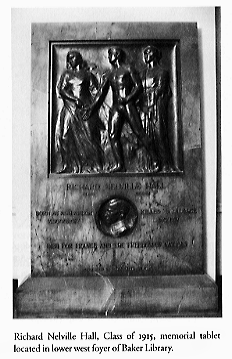Dartmouth College Library Bulletin
In the lower west entrance to Baker Library is a large tablet, the upper
portion in haut relief, memorializing Richard Nelville Hall, 1915, who died on
Christmas Day 1915 from the explosion of a German shell while serving as
ambulance driver with the American Field Service in France during World War I. On either side of the tablet are glass cases in which memorabilia are displayed
honoring Dick Hall and another Dartmouth ambulance driver, Howard B. Lines
1912. Lines died of pneumonia on 23 December 1916 and was buried on
Christmas Day at La Grange Aux Bois Argonne. These memorials have been in Baker
Library for several decades, and in recent years the cases had acquired a
neglected look. Noticing the dereliction for too long a time, the Library's
exhibitions designer together with a member of the Special Collections staff
refurbished the two cases last summer. The Lines case contains the temporary
wooden cross that had been placed on his grave in France, an Indian head emblem
cut from the canvas top of his ambulance, photographs, and a citation from the
16 Corps d'Armée, Section Sanitaire Américaine No. 1. 'Motif de
la citation: Conducteur dévoué et courageux, évacué
une première fois est revenu au front, a contracté dans le
service une maladie grave et est mort pour la France.'
On either side of the tablet are glass cases in which memorabilia are displayed
honoring Dick Hall and another Dartmouth ambulance driver, Howard B. Lines
1912. Lines died of pneumonia on 23 December 1916 and was buried on
Christmas Day at La Grange Aux Bois Argonne. These memorials have been in Baker
Library for several decades, and in recent years the cases had acquired a
neglected look. Noticing the dereliction for too long a time, the Library's
exhibitions designer together with a member of the Special Collections staff
refurbished the two cases last summer. The Lines case contains the temporary
wooden cross that had been placed on his grave in France, an Indian head emblem
cut from the canvas top of his ambulance, photographs, and a citation from the
16 Corps d'Armée, Section Sanitaire Américaine No. 1. 'Motif de
la citation: Conducteur dévoué et courageux, évacué
une première fois est revenu au front, a contracté dans le
service une maladie grave et est mort pour la France.'
The Dick Hall case contains a Red Cross emblem cut from Hall's shattered ambulance, a piece of the shell that killed him, photographs, and this statement:
Up on the mountains, fog was hanging over Hartmanns when word was brought to us that Richard Hall had fallen on the Field of Honor.
Gentlemen at home, you who tremble with concern at over-run puts, who bristle at your partner's play at auction, who grow hoarse at football games, know that among you was one who played for higher goals -- the lives of other men. There, in the small hours of Christmas morning, when mountain fought mountain -- on that hard-bitten pass under the pines of the Vosgian steeps, there fell a very modest and valiant gentleman.
Dick Hall, we who knew you, worked with you, played with you, ate with you, slept with you, we who took pleasure in your company, in your modesty, in your gentle manners, in your devotion and in your youth -- we still pass that spot, and we salute. Our breath comes quicker, our eyes grow dimmer, we grip the wheel a little tighter -- we pass better and stronger men.
Section Sanitaire Americaine No. 3
American Ambulance Field Service in France
Moosch, Alsace, December 27, 1915.
From a pamphlet in the Dartmouth Archives entitled The American Field Service a brief account of the activity of the ambulanciers is given:
At the outbreak of the World War, a number of young Americans, living in France, manned hastily improvised ambulances and helped bring in the wounded from the first Battle of the Marne.
From this spontaneous beginning there had developed, by April of 1915, the American Field Service, created and directed by the late A. Piatt Andrew. To this Service were attracted some twenty-five hundred American volunteers from nearly every state in the Union, and from more than a hundred American colleges or universities.
They carried wounded from practically every important battle along the French front: in 1915, from the plains of Flanders during the battles of Ypres and the Yser, from the hills of northern Lorraine during the violent engagements in the Bois le Prêtre, and in the mountains and valleys of reconquered Alsace during the battles of Fecht and Hartmannsweilerkopf. In 1916, during the battle of Verdun, they were everywhere in that sector from the Woevre to the Argonne, and in the autumn of that year two of their sections were sent to the Balkans where they worked during the following year with the French troops in the mountainous regions of northern Greece, Serbia, and Albania. The year 1917 found American Field Service sections carrying wounded from every great engagement from the April battle in Champagne to the October battle on the Chemin des Dames.
The thirty-one ambulance sections served with sixty-six French divisions, and carried from the front line trenches to the first dressing stations more than half a million wounded.
The French Army awarded nineteen decorations to the American Field Service sections, and conferred the Croix de Guerre, the Medaille Militaire or the Legion d'Honneur upon two hundred and fifty of their members.

A number of Dartmouth men served with the Ambulance Corps and Dartmouth students donated two ambulances to the operations of the American Field Service in Alsace, Lorraine, and Champagne. The College Archives has three bodies of papers from men who served with the Ambulance Corps regarding their war service, those of Howard B. Lines, George E Ingalls 1915, and Edward C. Kirkland 1916. Those of Kirkland contain two volumes of typed letters from the Front. In addition, the Archives has a good collection of photographs that include two photograph albums depicting the activities of the Ambulance Corps. A number of published works are housed in the Archives and in the general stacks that give details of the ambulanciers' experiences and history of the American Field Service in France. One such title is At the Front in a Flivver by William Yorke Stevenson, Section No. 1, American Ambulance (Boston, Mass.: Houghton Mifflin Company, 1917). Another is Henry James's Within the Rim and Other Essays 1914-15 (London: W. Collins Sons & Co., 1918), which includes his 'The American Volunteer Motor-Ambulance Corps in France: A letter to the Editor of an American Journal.' Other materials relating to this activity are individually catalogued letters, certificates, magazine articles, and newspaper cuttings.

Mention should be made regarding the concern Edward Tuck 1862 and Julia Stell Tuck, 'friends of France,' had for refugees and civilian and military casualties at the outbreak of the war. The Tucks were prompt to assist with aid to them. They set up the Hôpital Stell at their Paris estate,'Vert-Mont,' to care for wounded soldiers. The hospital, accepted by the French Army, was entirely supported by the Tucks. Ambulances were housed and repaired in the estate garage. Food to supplement the meager war rations was supplied from the Tuck farm at Montesson. Edward Tuck was the donor of the Richard Nelville Hall memorial tablet. The sculptor was L. A. Lejeune.
A third Dartmouth man, Stanley Hill 1918, was fatally wounded while driving an ambulance for the U.S. Army Ambulance Service. Hill had enlisted with the first Dartmouth Unit of the American Field Service Ambulance Corps but was transferred to the Army after the United States entered the war. A shower built in Alumni Gymnasium with funds Hill left to Dartmouth College was '. . . dedicated in his name to the brave and clean young manhood of his beloved Dartmouth, that life is long which answer's life's great end.'
The American Field Service still exists as an organization, primarily to promote international understanding through exchange students from more than sixty countries.

There were two Dartmouth Dick Halls who died as young men. One is mentioned in this article and the other is the one for whom Dick's House or Dick Hall's House is named. Richard Drew Hall 1927 died in his sophomore year from infantile paralysis. His parents, Edward K. Hall 1832 and Sally Drew Hall, gave the College the infirmary named in his memory.